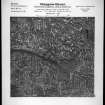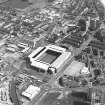Glasgow, Govan, General
General View (Period Unassigned)
Site Name Glasgow, Govan, General
Classification General View (Period Unassigned)
Canmore ID 70579
Site Number NS56NE 571
NGR NS 55 65
Datum OSGB36 - NGR
Permalink http://canmore.org.uk/site/70579
- Council Glasgow, City Of
- Parish Govan (City Of Glasgow)
- Former Region Strathclyde
- Former District City Of Glasgow
- Former County Lanarkshire
GOVAN
In 1575 Govan was described as 'A gret and ane large village upon the Watir of Clyde'. By 1790 the population of 2,518 was mainly salmon fishers, weavers or engaged in other rural occupations. Even into the 1830s Govan was a quiet semi-rural location, although there had been a colliery at Drumoyne, south of Elder Park. By the 1840s shipbuilding and the attendant railways had destroyed the quiet.
William Hamilton started feuing Middleton estate for building in the 1840s. He sold 4 hectares (10 acres) to Alexander Reid for tenements but only a few were built along Paisley Road West before the 1890s, when Archibald Stewart & Company completed them. Tenement building had begun in 1866 at Greenfield feued by the Good family and at Helen and Robert Streets the same year. In 1896 the Glasgow Subway Workshops were opened at Broomloan Road. More Hamilton lands, including J & G Thomson's Clyde Shipyard and Cessnock Bank Villa, were bought by the Clyde Navigation Trust to construct Cessnock Dock, later Princes Dock, which opened in 1897. The dock, with three mooring basins, three graving docks and large timber stores, was used to export Lanarkshire coal and to import iron ore and limestone.
By 1904 the population of Govan had reached 90,908, living in tenements, and it was the fifth largest Burgh in Scotland when annexed by Glasgow in 1912. There were three ferries across the Clyde: the Highland Lane passenger ferry to Kelvinhaugh; the Water Row vehicular Govan ferry to Ferry Road, Partick; and the Govan Wharf passenger Govan Ferry West to Meadowside.
Taken from "Greater Glasgow: An Illustrated Architectural Guide", by Sam Small, 2008. Published by the Rutland Press http://www.rias.org.uk
Glasgow, Govan, 20 Drumoyne Terrace.
Precise location uncertain at time of upgrade, 10.7.2000.
Glasgow, Govan, Govan Coal Companies Railway.
Precise site uncertain at time of upgrade, 23.10.2000.























































